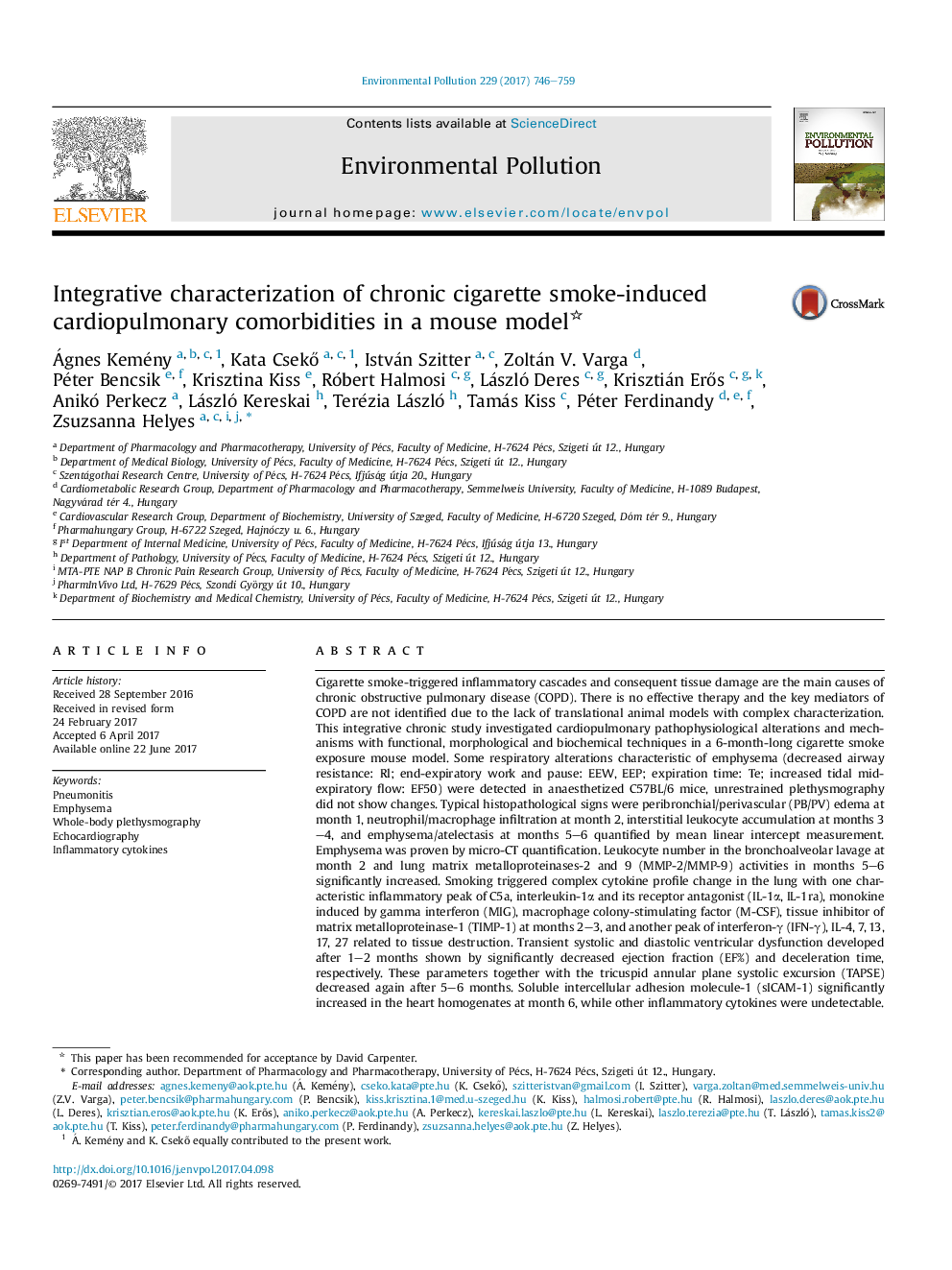| Article ID | Journal | Published Year | Pages | File Type |
|---|---|---|---|---|
| 5748822 | Environmental Pollution | 2017 | 14 Pages |
â¢We optimized and characterized a COPD mouse model with translational relevance.â¢Chronic cigarette smoke induces duration-dependent cardiopulmonary co-morbidities.â¢Smoke-triggered IL-1-driven inflammatory cascades and pulmonary damage induce COPD.â¢Lung MMP-2/9 increase parallel to the late structural damage like in human condition.â¢sICAM-1 may have a role in smoke-induced systolic and diastolic cardiac dysfunction.
Cigarette smoke-triggered inflammatory cascades and consequent tissue damage are the main causes of chronic obstructive pulmonary disease (COPD). There is no effective therapy and the key mediators of COPD are not identified due to the lack of translational animal models with complex characterization. This integrative chronic study investigated cardiopulmonary pathophysiological alterations and mechanisms with functional, morphological and biochemical techniques in a 6-month-long cigarette smoke exposure mouse model. Some respiratory alterations characteristic of emphysema (decreased airway resistance: Rl; end-expiratory work and pause: EEW, EEP; expiration time: Te; increased tidal mid-expiratory flow: EF50) were detected in anaesthetized C57BL/6 mice, unrestrained plethysmography did not show changes. Typical histopathological signs were peribronchial/perivascular (PB/PV) edema at month 1, neutrophil/macrophage infiltration at month 2, interstitial leukocyte accumulation at months 3-4, and emphysema/atelectasis at months 5-6 quantified by mean linear intercept measurement. Emphysema was proven by micro-CT quantification. Leukocyte number in the bronchoalveolar lavage at month 2 and lung matrix metalloproteinases-2 and 9 (MMP-2/MMP-9) activities in months 5-6 significantly increased. Smoking triggered complex cytokine profile change in the lung with one characteristic inflammatory peak of C5a, interleukin-1α and its receptor antagonist (IL-1α, IL-1ra), monokine induced by gamma interferon (MIG), macrophage colony-stimulating factor (M-CSF), tissue inhibitor of matrix metalloproteinase-1 (TIMP-1) at months 2-3, and another peak of interferon-γ (IFN-γ), IL-4, 7, 13, 17, 27 related to tissue destruction. Transient systolic and diastolic ventricular dysfunction developed after 1-2 months shown by significantly decreased ejection fraction (EF%) and deceleration time, respectively. These parameters together with the tricuspid annular plane systolic excursion (TAPSE) decreased again after 5-6 months. Soluble intercellular adhesion molecule-1 (sICAM-1) significantly increased in the heart homogenates at month 6, while other inflammatory cytokines were undetectable. This is the first study demonstrating smoking duration-dependent, complex cardiopulmonary alterations characteristic to COPD, in which inflammatory cytokine cascades and MMP-2/9 might be responsible for pulmonary destruction and sICAM-1 for heart dysfunction.
Graphical abstractDownload high-res image (174KB)Download full-size image
